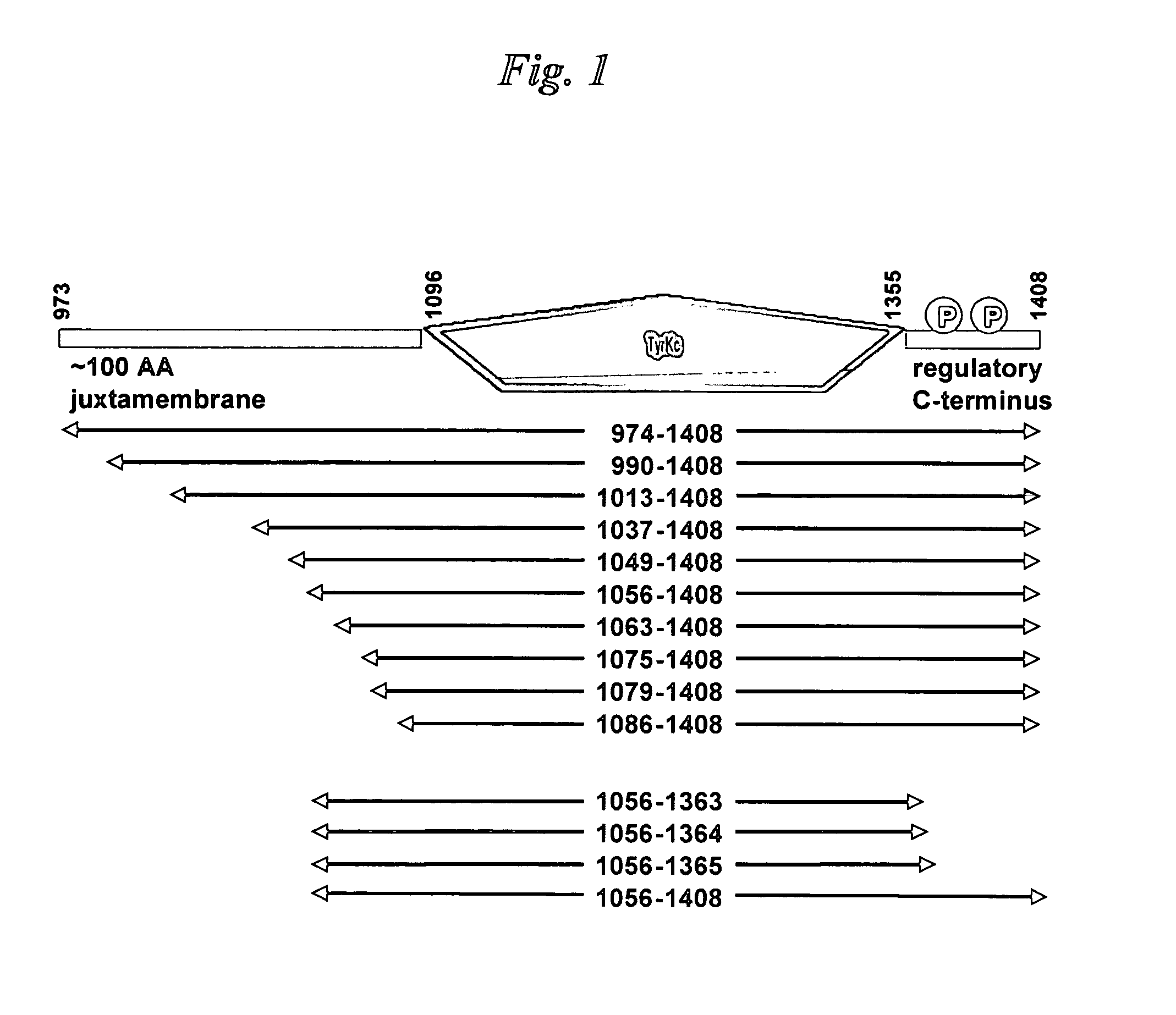Nucleic acids encoding kinase and phosphatase enzymes, expression vectors and cells containing same
a technology of kinase and phosphatase enzymes, which is applied in the field of expression vectors and cells containing same, can solve the problems of difficult crystallization, interference with normal activity and/or normal structure, etc., and achieve the effect of improving crystallization, crystallization and/or crystal quality of polypeptides, and improving crystallization quality
- Summary
- Abstract
- Description
- Claims
- Application Information
AI Technical Summary
Benefits of technology
Problems solved by technology
Method used
Image
Examples
example 1
Engineering a Bicistronic Vector Encoding Both Abl Kinase Domain and PTP1b Phosphatase Domain
[0098]The bicistronic vector engineering used, as a starting material, a previously-engineered vector that encodes human Abl (Abelson tyrosine kinase) kinase domain extending from Abl residue Gly 227 through to residue Val 515, termed pET-SPEC BI-PTP Abl G227-V515-X. The section of this plasmid that encodes Abl kinase and PTP1b domains on a bicistronic mRNA transcript is shown in Table 2. The remainder of the vector is a derivative of the pET-24 vector (Novagen) designed to utilize the T7 RNA polymerase for producing mRNA in strains of E. coli that are engineered to produce that polymerase.
[0099]A DNA fragment encoding the human PTP1b phosphatase domain extending from PTP1b residue Met 1 through to residue Gly 283 was engineered using PCR. The template for the PCR reaction was a previously-engineered human PTP1b cDNA derived from a purchased total human brain cDNA library (Invitrogen). Custo...
example 2
Expression in E. coli of His-tagged Abl Protein from pET-SPEC BI-PTP Abl G227-V515-X
[0103]To obtain protein expression of dephosphorylated Abl, the pET-SPEC BI-PTP Abl G227-V515-X DNA was transfected into the E. coli strain BL21-CodonPlus(DE3)-RIL (Stratagene) using standard methods, with dual antibiotic selection of kanamycin and chloramphenicol. E. coli harboring the plasmid were grown in liquid culture at 37° C. with shaking to an OD600=1, at which point the culture temperature was reduced to 15° C., and the 0.5 mM IPTG inducing agent was added. The culture was then shaken for 18 hrs at 15° C., at which point the E. coli was concentrated by centrifugation.
[0104]The E. coli pellet, 0.5 g, was suspended in 10 ml buffer (50 mM Tris pH 7.5, 250 mM NaCl, 0.1% Triton-X-100, 0.02% monothioglycerol, 20 uM phenylmethylsulfonyl chloride). Extraction was initiated by addition of lysozyme (Sigma) to 200 ug per ml, incubation on ice for 15 min, and sonication for 1 min. Solution was centrifug...
example 3
Determination that Abl Co-Expressed with Phosphatase is Not Phosphorylated
[0106]Abl proteins expressed either with or without PTP coexpression were evaluated for state of phosphorylation detectable with an antibody that specifically binds phospho-Tyr (PY20 mouse monoclonal IgG2b, SantaCruz Biotechnology). Samples of Abl made from each expression vector were separated by size using SDS-PAGE, then transferred by electro-blotting onto Imobilon-P membrane (Millipore) in transfer buffer (39 mM Glycine, 48 mM Tris HCl, 20% MeOH, 0.0375% SDS). The membrane was stained with coomassie to visualize the Abl proteins. Before exposure to antiserum the membrane was exposed to phosphate-buffered saline containing 0.1% Tween detergent and 5% bovine serum albumin to reduce background antibody binding. The paper was then exposed for 2 hr at room temperature to 1:1000 dilution of PY20 antibody prepared in the same buffer. After washing, membrane was exposed for 2 hr at room temperature to 1:5000 dilut...
PUM
| Property | Measurement | Unit |
|---|---|---|
| temperature | aaaaa | aaaaa |
| temperature | aaaaa | aaaaa |
| pH | aaaaa | aaaaa |
Abstract
Description
Claims
Application Information
 Login to View More
Login to View More - R&D
- Intellectual Property
- Life Sciences
- Materials
- Tech Scout
- Unparalleled Data Quality
- Higher Quality Content
- 60% Fewer Hallucinations
Browse by: Latest US Patents, China's latest patents, Technical Efficacy Thesaurus, Application Domain, Technology Topic, Popular Technical Reports.
© 2025 PatSnap. All rights reserved.Legal|Privacy policy|Modern Slavery Act Transparency Statement|Sitemap|About US| Contact US: help@patsnap.com

